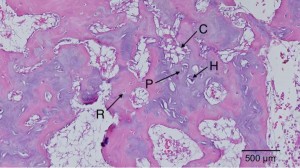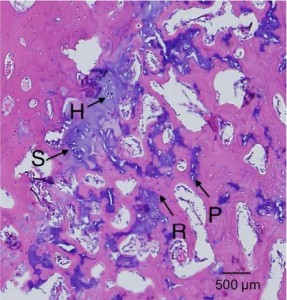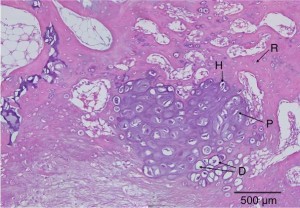The idea of LSJL is to create microgrowth plates via fluid shear strain on the mesenchymal stem cells in the bone marrow. This study shows that microgrowth plates can exist:
Growth Plate Regeneration Using Polymer-Based Scaffolds Releasing Growth Factor
“Depending on the type of growth plate fracture and the severity it can lead to stunted bone growth or bone growth deformation. The current treatment options for growth plate fracture are removal of the bony bar and replacing it with a filler substance, such as, bone cement or fat, but still yield poor results 60% of the time. In previous work, poly(lactic-co-glycolic acid) (PLGA) scaffolds were developed and studied in vivo for the purpose of growth plate regenerationDepending on the type of growth plate fracture and the severity it can lead to stunted bone growth or bone growth deformation. The current treatment options for growth plate fracture are removal of the bony bar and replacing it with a filler substance, such as, bone cement or fat, but still yield poor results 60% of the time. In previous work, poly(lactic-co-glycolic acid) (PLGA) scaffolds were developed and studied in vivo for the purpose of growth plate regeneration”
“Figure 6.7. Fat implant showed thin, continual line of cells across medial side that contained reserve (R), proliferative (P), hypertrophic (H) cartilage cells and calcification zones (C).”
Another micro growth plate:
“Blank scaffold on (A) the lateral side with columnar structure and (B) the medial side with the appearance of stacked (S), reserve (R), proliferative (P), and hypertrophic (H) cartilage cells.”
Here’s a growth plate but loaded with IGF-1 so it’s much more sophisticated:
“IGF-I loaded scaffold showed dispersed pockets of cartilage cells throughout the medial side with the appearance of reserve (R), proliferative (P), hypertrophic (H), and degenerative zones (D).”
“In this study, the attempt to regenerate the growth plate did not result in columnar structure to the degree that the native growth plate has, regardless of the treatment type. It appeared that the fat implant allowed for some cartilage regeneration, but it was only a cell wide at most points and most of the chondrocytes were in the calcification zone. The tissue surrounding the cartilage areas was woven bone, which has been known to appear after fractures{But would this still result in a longer bone?}. The blank scaffold treatment resulted in tissue having a similar structure to that for the fat implants with a couple exceptions. First, there were a few areas where blank scaffolds had been placed with some cellular stacking, and secondly, the lateral side retained more structure, resembling that of the native growth plate, compared to defects treated with fat graft. The blank scaffolds gave the epiphyseal region more structural support, preventing further collapse of the lateral growth plate, while the fat graft implant had a thinner growth plate region across the whole tibia.”
“The defects treated with IGF-I-loaded scaffolds, both with or without seeded cells, showed a similar appearance on the lateral side as that of the blank scaffold group, however the medial sides were quite different. Without cells, the IGF-I-loaded scaffold resulted in pockets of chondrocytes throughout the medial side along the epiphyseal line that contained cells in all zones of cartilage development. The addition of cells created a large vertical pocket (~3 mm long) of chondrocytes located in the upper epiphyseal region. Interpretation of the IGF-I loaded samples was limited because only one sample could be used for observation so it is difficult to say if this cellular organization would occur again. The cells were mostly in the hypertrophic state and had no columnar organization. Both types of IGF-I loaded scaffolds (with and without cells seeding) increased the density of hypertrophic chondrocytes compared to the fat, blank, and hybrid scaffolds. Cells seeded on scaffolds containing IGF-I created the largest population of chondrocytes”
“Though the results did not show total growth plate regeneration, the necessary cell types were present”
It should be noted the mesenchymal stem cells used in this study were harvested from the diaphysis thus providing evidence that MSCs needed to create growth plates do not necessarily have to be from the Zone of Ranvier.
The study did not display changes in length due to the various scaffolds. The fat scaffold and IGF-1 seeded scaffold did reduce the angular measurement resulting from part of the growth plate being damaged. The blank scaffold altered the angular measurement disparity but increased it in the tibia and decreased it in the femur. We can be fairly certain that microgrowth plates can alter longitudinal bone growth as the angular measurement is dependent on how tall one side of the bone grows versus the other.
Even though this study involves scaffolds and LSJL does not. The information about microgrowth plates altering height growth can be extrapolated to LSJL as MSCs could migrate to the epiphyseal region and use bone as a natural scaffold.
This study provides evidence that you don’t need to create a whole growth plate to increase height.




Bone growth always seemed possible in my head, I think the true problem to why we can’t grow bones decently today is because it’s not considered a health problem to have small bones, in fact, having a small frame greatly increases your life Life expectancy, it means that you’ll use less energy, keeping vital parts of your body healthy for a longer time.
That means that there won’t be big research groups focusing on that.
It seems very possible to grow bones in theory, medicine simply lacks knowledge on the matter.
Hey this comment isn’t really related to this post, but since it was recent I figured it was the only place i might get this question answered by either Michael or Tyler.(I did ask this question before,but since i didn’t get any reply from you guys i thought you weren’t going to check that thread anytime soon)
It’s about glucosamine sulphate
If my growth plates are still open and I’m doing plenty of stretching exercises(mostly the ones from School of Height by A.S Palko) alongside some intense cardio exercises (and getting plentiful sleep and nutrition of course) can I take this to speed up my growth?
If so, will it be possible for me to maximize my final height to 5″7 or 5″8? (my height was predicted to be 5″6, but I’ve read that it’s possible to exceed that by possibly 3-4 inches)
I really could use an answer, please do reply as soon as possible